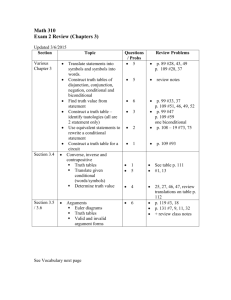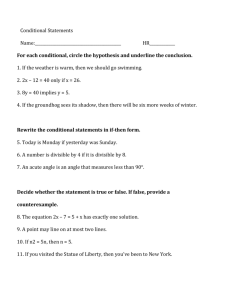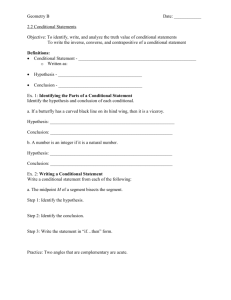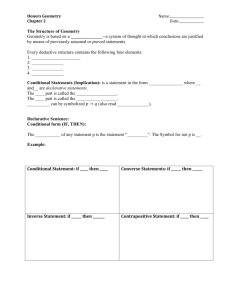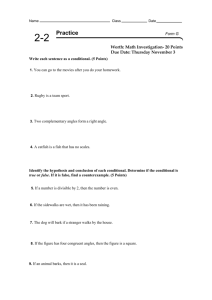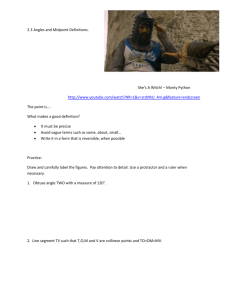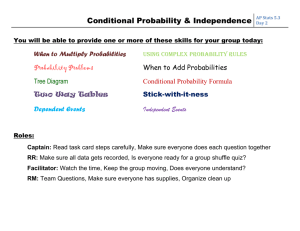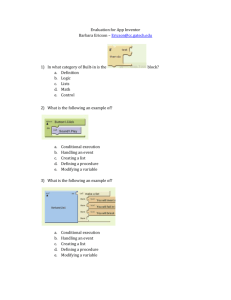Conditionals, Inverse, Converse, and Contrapositive
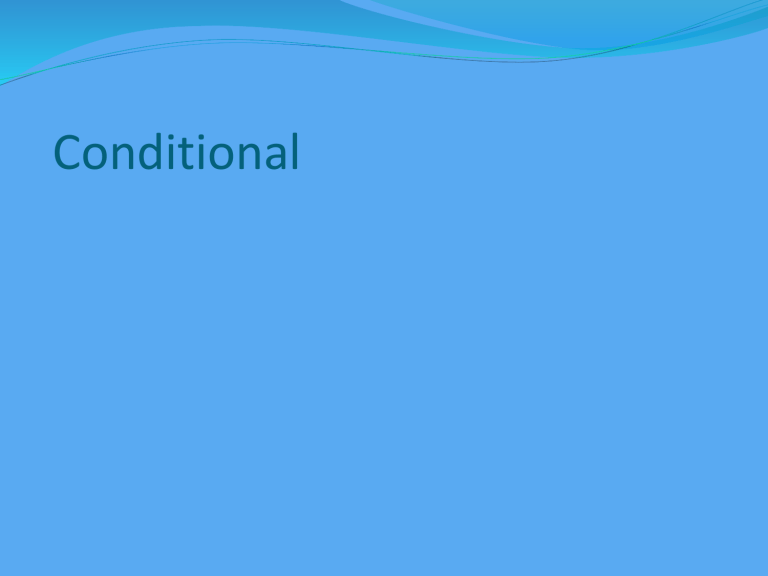
Conditional
Conditional Statements
Vocabulary
Conditional: A compound sentence formed by using the words if….then.
Given the simple sentences p and q, the conditional would be
Hypothesis: Also called the antecedent, it is the first part of the conditional represented above by the letter p and usually follows the word if.
Conclusion: Also called the consequent, it is the latter part of the conditional represented above by the letter q and usually follows the word then.
Example:
Let p represent “You will get an A in Geometry.” (true)
Let q represent “I will buy you a new graphing calculator.” (true)
“If you get an A in Geometry, then I will buy you a new graphing calculator.”( )
Note: In order for a conditional statement to be false, the hypothesis (p) must lead to a false conclusion (q).
Decide if the conditional statement is true or false.
1)“If you get an A in Geometry then I buy you a new calculator.” (true)
2)“If you get an A in Geometry then I do not buy you a new graphing calculator.” (false)
3)“If you do not get an A in Geometry then I buy you a new graphing calculator.”
( true
)
4) “If you do not get an A in Geometry then I do not buy you a new graphing calculator.”
( true
)
Try These
Example 2:
Let m represent ”Monday is the first day of the week.” (True)
Let w represent “There are 52 weeks in a year.” (True)
Let h represent “ An hour has 75 minutes.” (False)
For each of the conditionals, write the sentence which it represents and determine the truth value.
m → w w → h
~w → m
→ h
Hidden Conditionals
Often the words “if…then” may not appear in a statement that does suggest a conditional. Instead, the expressions “when” or “in order that” may suggest that the statement is a conditional.
Example: Turn the hidden conditional statement into “if…then” statements
1)“When I finish my homework I will go to the movies.”
If I finish my homework, then I will go to the movies.
2) “In order to succeed you must work hard.”
If you want to succeed, then you must work hard.
Truth Values
A conditional statement is true for all cases with the exception of a statement with a true hypothesis and a false conclusion.
Note the truth table below.
T
F p
T
F
F
T q
T
F
T
T
T
F
Complete the following truth table
p q ~p
1.
2.
p q ( q
What is the Converse,
Inverse and Contrapositive of a conditional statement?
Write the converse of the statement in the cartoon:
If they send the get-well card , then you will send the proof of purchase
The converse of a conditional is formed by reversing its hypothesis and conclusion
You break it, you buy it p : you break it q : you buy it
Conditional:
If you break it , then you buy it p q
If you do not break it , then you do not buy it
~p ~q
The inverse of a conditional negates the hypothesis and the conclusion
Black cats b : I am a black cat c : I am a cat
Cats
If I am a black cat , then l am cat b c
If I am not a black cat , then l am not a cat
~b ~c
If I am not a cat , then l am not a black cat
~c ~b
The Contrapositive of a conditional
Negates and Reverses the hypothesis and the conclusion
Conditional p q
Converse q p
Inverse
~p ~q
Contrapositive
~q ~p
Fill in the truth value, make a conclusion about conditionals and contrapositives p q ~p ~q p q ~q ~p
What do you notice about the conditional and the contrapositive?
A conditional and its contrapositive are
Logically equivalent
(They always have the same truth value)
p
q is the same as ~q
~p
p: The shape is a square q: The shape is a rectangle squares rectangles
1) Write a conditional sentence that represents the Venn diagram.
If the shape is a square, then it is a rectangle
2) Write in symbolic and sentence form a) The converse b) The inverse c) The contrapositive
